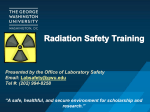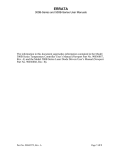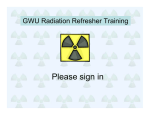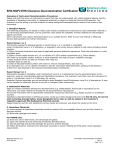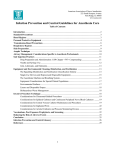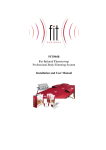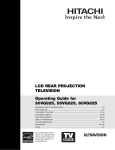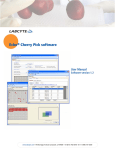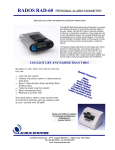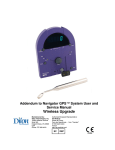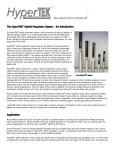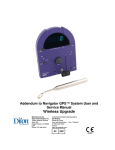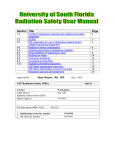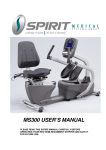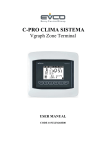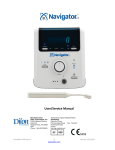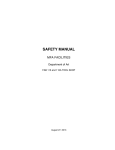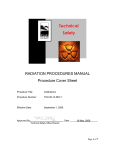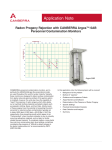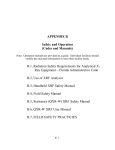Download THE GEORGE WASHINGTON UNIVERSITY
Transcript
THE GEORGE WASHINGTON UNIVERSITY AUTHORIZED USER’S MANUAL Radiation Safety Policies For Use of Radioactive Material in Research Revised 11/20/13 Administered by The Radiation Safety Committee Through The Office of Laboratory Safety - Radiation Safety Ross Hall, Rm 325B 202-994-2630 Table of contents I. Overview A. Licensing B. Program structure II. Authorization and approved use of RAM A. Authorized users B. Lab requirements C. Users D. Renewals E. Amendments III. Program requirements A. Obtaining RAM B. Working with RAM a. Protective equipment b. ALARA c. Survey Meters and Liquid Scintillation Counters d. RAM use area e. Surveying f. Monthly surveys g. Contamination h. Hygiene C. Dose Limits D. Inventory and Disposal a. Dry solid Material b. Liquid radioactive waste c. Stock vials d. Scintillation vials E. Waste shielding IV. Emergency response A. Contamination on clothing B. Contamination on skin C. Spills V. Required training VI. Audits and surveys VII. Personal dosimetry VIII. Pregnancy declaration IX. Security 1 I. Overview of the GW radiation safety program A. Licensing GW has a broad scope license issued by the U.S. Nuclear Regulatory Commission (NRC) under Title 10 of the Code of Federal Regulations. This type of license allows a large variety of isotopes to be used within activity limits and allows the GW Radiation Safety Program to authorize users and locations of use. This provides the flexibility needed for a research institution. In order to have this high degree of autonomy, GW must operate according to the license agreement made with the NRC which includes the appointment of an RSO, establishment of a Radiation Safety Committee, and other specific requirements. B. Radiation safety program structure The radiation safety program is administered in the Office of Laboratory Safety (OLS) located in 325B Ross Hall. OLS reports to the Office of the Vice President of Research (OVPR). The program addresses all radioactive materials (RAM) and radiation producing machines used on any GW campus. It should be noted that the GW Hospital is a separate entity and operates under a separate license. The university has appointed a Radiation Safety Officer (RSO) to administer the radiation safety program. The RSO has been selected based on appropriate training and experience and has been explicitly approved by the NRC. The RSO has the authority, designated by the Office of the University President, to implement the Radiation Safety Program. The RSO has authority to direct the activities of all relevant personnel in relation to any imminent hazard from RAM to the faculty, staff, students, public, or environment. The university has established a Radiation Safety Committee (RSC) to oversee the use of radioactive material, review and approve authorized users and use of radioactive material, and ensure that the radiation safety program functions as intended. The committee is comprised of at least 4 members, including 2 Authorized RAM users. Meetings are held quarterly, but special meetings can be scheduled to conduct the business of the committee. The RSC is responsible for working in conjunction with the RSO to maintain regulatory compliance. Principal investigators (PI) may use RAM once they have been approved by the RSO and the RSC and then must abide by this the program requirements covered in this guide and in training. They are then considered an Authorized User (AU). II. Authorization and approved use of RAM A. Authorized Users A responsible principle investigator is a one that has control of laboratory space and as such, is the authority for safety in the lab. In order for a responsible PI to control RAM (use or storage) he/she must become an Authorized User (AU). Only a responsible PI can become an AU. Those who work under an AU can become users (discussed later). For a PI to become an AU he/she must be approved by the RSC which will look for certain qualifications based on training and experience as well as a genuine need to use RAM. The minimum qualifications are: a. At least 2 years of experience using isotopes similar to the uses being proposed and at least one year as an authorized user at another institution. OR b. 40 hours of training and experience in safe radioactive material handling; ALARA concepts; characteristics of ionizing radiation; units of radiation, dose and activity; radiation detection instrumentation; and biological hazards of radiation; appropriate to the type and form of isotope to be used. The following items must be submitted to the RSC for AU consideration: A completed “New Authorization” form 2 Protocol submission form – Fill one form out for each protocol. Be sure to completely illustrate all hazards, steps in the protocol, radiation safety precautions to be taken on each step, and specific waste expected to be produced after the procedure. Rad lab commission form – For each room to be used with RAM. The form includes a diagram of the room layout designating work areas, waste storage, inventory storage, etc. The commissioning form does not need to come in with the rest of the documents as OLS will help with the details. New user & dosimetry evaluation form – For each worker who will work with RAM. Each AU must have a binder which contains at a minimum: This guide utilization logs (if not stored elsewhere) Description of the Protocols NRC Reg. Guides 8.29 and 8.13 Perkin Elmer publication “Guide to the safe handling of radioactive materials in research” isotope informational pages for the isotopes you use Past inspection surveys Documented Monthly Surveys B. Lab Requirements If approved, an authorization document will be given to the PI and on will be kept of file in the Office of Lab Safety. The authorization will have information for that AU including: isotopes and specific compounds that can be used, annual and on hand activity limits, rooms for use and storage, workers trained to handle RAM, and any special instructions. The room will be inspected to make sure it meets the requirements for a radiation room including: The room must be a high quality chemical laboratory Spaces that are not lab related, such as classrooms, may not open off the laboratory and any other labs or offices adjoining must be solely for use by laboratory workers. The lab must have adequate space, lighting Have adequate ventilation (at least 8 air changes per hour) The refrigerators or freezers, to store RAM, must be lockable and the room must have a locking door for security. The room should be easily cleanable with non-absorbent material and be painted with a hard washable high quality paint. Labs that plan to dispose of liquid RAM down a hot sink, must have a designated sink in the lab where the protocol is to be performed, that has been labeled and approved by OLS. The sign at the entrance to the suite from the hall must have radiation marked and every room that has radioactive work must have a sign at the entrance stating “CAUTION, RADIOACTIVE MATERIAL”. C. Users For individuals to use RAM they must do the following: Their PI must be an Authorized User (AU) Initial training and exam – candidate must read this document and the Perkin Elmer document entitled “Guide to the safe handling of radioactive materials in research”. Then sit for a short, hands-on training session and finally pass a written test. The candidate must be trained on the approved protocol, and then work with supervision until the AU decides that they are proficient. 3 D. Renewals AUs must renew their programs annually. Following are elements of the renewal process: A renewal form will be sent to an AU by email and it should be corrected for any errors or changes and returned to OLS. If an AU wants to add or change a protocol, add a room, add and isotope, or increase an activity level he/she must fill out an amendment form (see amendments) An inventory of RAM on hand will also be sent for each AU to physically inventory stock vials. The AU can add notes to the inventory to reconcile any changes or corrections. This form shall be returned to OLS. An updated awareness training document may be sent as well if the training has changed. See the training section for details on this. E. Amendments If a substantial change is needed for research such as adding a room or isotope or adding or changing a protocol or increasing activity limits, then an amendment form is required as well as RSC approval. If the change is minor or deemed by the RSO to be of low risk, the RSO can issue a tentative approval until the change can be reviewed and approved by the RSC. III. Program requirements A. Obtaining RAM RAM orders must be placed through the EAS oracle system or iBuy for proper approval by OLS. RAM should never be obtained outside of the approval process, unless specific permission has been given to a single order from OLS. When placing an order, make sure it complies with your specific authorization requirement including: The AU is authorized for that isotope Not exceeding your annual or on-hand limits Note: Since source vials count against your limits it is good to have empty source vials picked up for disposal frequently so that you do not go over your limits. If your limits are too low for your use, please submit an amendment to your authorization to adjust your limits in order to avoid any problems with ordering. When ordering RAM ensure that the administrative person placing the order includes the correct information: “ship to” address price DOT hazard class (7) Shipping charges Supplier item # location Upon receiving a RAM package OLS will conduct the appropriate surveys and deliver it to your room. An approved user must sign for the package and the package must be secured immediately. OLS will leave the shipping paper and a new utilization log for your records B. Working with RAM a. Protective equipment Proper protective equipment must be worn when working with RAM including the following: Lab coat – A lab coat must always be worn when handling RAM. If handling a long-lived isotopes such as 3H or 14C, disposable lab coat may be considered since contaminated lab coats can not be sent to laundry or stored for decay. 4 Gloves – Exam gloves at a minimum are always to be worn when handling RAM. Latex gloves may be worn if there are no hazardous chemicals used such as poisons or corrosives. If these hazardous chemicals are present, the proper gloves must be worn; generally nitrile is the best choice. Double gloving is a good idea with time sensitive experiments; if a glove becomes contaminated then the outer one can be quickly removed and work will not be interrupted. Eye protection – Eye protection is required for all RAM use due to the possibility of splashes. Goggles and face shields should be considered when larger quantities are in use. Only close toed shoes and long pants should be worn when working with RAM to cover exposed skin where spills can occur. Long hair must be cinched up and avoid baggy clothes and dangling jewelry. b. ALARA - As Low As Reasonably Achievable ALARA is the practice of reducing doses as much as possible using the techniques of distance, time and shielding. This topic is covered in a document entitled: “Guide to the safe handling of radioactive materials in research” which can be found in your yellow binder and as a result will not need to be covered here. The principles in this document should be applied for all RAM handling including stock vials, research work and waste. c. Survey Meters and Liquid Scintillation Counters Each lab must have the proper equipment to detect radiation including access to a liquid scintillation counter. For beta emitters a GM meter with a pancake probe or end window probe is required. For gamma emitters such as 125I and 51Cr a survey meter with a low energy gamma scintillation detector (e.g.: Ludlum Model 44-3) must be used. Liquid scintillation counting is the only way to detect 3H and is also effective to detect the other common low energy beta emitters, 14C and 35S. Survey meters have low sensitivity for 35S and 14C. It is also the only way to detect removable contamination and as such is required for monthly contamination surveys (to be covered later). Survey meters when used must have been calibrated within 1 year of the date of the use. Basis instruction for using survey meters: • Always check batteries to make sure they are in range. • Check the meter before each use by holding the probe against the check source. The reading should closely match the calibration number on the sticker. • A properly working GM meter has a background count rate of about 40 cpm. A survey meter with a Ludlum Model 44-3 low energy gamma detector has a background of 250 to 400 cpm. • If it is not working contact OLS. d. RAM Use Area RAM use is only to occur in rooms that are authorized for the particular isotope being used. RAM is only to be used in designated use areas that are marked with radiation tape and protected with plastic backed absorbent paper (or equivalent). Also, any equipment or other areas such as hoods, refrigerators, centrifuges, etc must be labeled with “rad “tape or labels. e. Surveying As you work, survey your gloves frequently to detect any contamination and discard them as rad waste if contaminated. The survey meter must be turned on at all times when working with RAM. Survey meters are not required if ONLY 3H is used. When work is finished hands, feet, clothing, benches, floors and other equipment should be surveyed to detect any contamination. Move the detector slowly for effective detection. “No contamination” is defined as the following: • < 2X background (survey meter) • < 150 cpm (LSC gross counts wide window wipe test) 5 f. Monthly Surveys Each AU is responsible for insuring that a survey of their authorized use areas is documented each month. The survey form with a drawing of the room is provided by OLS and should be used to indication of where wipe tests were collected as well as to check other compliance items. A print-out of the LSC swipe results must be attached to the form when completed. OLS can train people in your lab on conducting surveys and using an LSC. The LSC in Ross 632 can be used by all labs for conducting surveys. Please contact OLS prior to use of the equipment in 632 to insure it does not interrupt another lab’s work. g. Contamination No contamination should be present outside of RAM use areas. If contamination is discovered, it must be cleaned up immediately. If you suspect H3 contamination perform wipe tests. Using wipe tests to monitor for S35 & C14 is also recommended. Contamination in work areas should be avoided as much as possible and if discovered, cleaned as soon as work is complete. All contaminated bench paper must be discarded as radioactive Dry Solid Material (DSM). Small amounts of contamination may reside in work areas due to residual in equipment. This may not be completely unavoidable but must be below levels covered in the “exposure limits” section covered later. Contamination can be cleaned using decontamination agents such as Count-Off or Radiacwash or normal cleaning agents such as 409 or Scrubbing Bubbles and paper towels. Repeat the decontamination efforts until there is no detectable contamination. If you can not clean up contamination by yourself or you don’t feel comfortable cleaning it up, contact OLS for assistance and inform the AU. Call OLS for any contamination on skin or clothes. Clothes that are contaminated with a short-lived isotope must be stored for 10 half-lives to allow the isotope to decay. Clothes contaminated with long halflife isotopes will be disposed of as radioactive waste. h. Hygiene No eating, drinking, chewing gum or applying cosmetics is permitted in areas designated for use of RAM. Food or food related items should never be stored in refrigerator/freezers designated for storage of RAM. Wash your hands promptly after handling any RAM. C. Dose Limits NRC Regulations set dose radiation dose limits for occupationally exposed individuals. GW has adopted dose limits that are 10% of these limits as part of keeping with our goal to keep doses as low as reasonably achievable (ALARA). These limits and goals are summarized in the following table: NRC Dose limit mrem/yr GW ALARA Dose Limits Level I mrem/Calendar Qtr Whole body 5000 125 Lens of the eye 15000 375 Skin, hands, feet or single organ 50000 1250 Fetus of declared pregnant worker 500 50 Unrestricted area dose limit 2 mrem in any 1 hour 0.5 mrem in any 1 hour or 0.5 mrem/h Body part, tissue or organ The limits for the public unrestricted areas and RAM use area areas. Public Dose from Use of Licensed Material 100 mrem/yr Unrestricted Areas No more than 2 mrem in any 1 hour 6 >> Practical Application of Survey Meters to help meet ALARA limits When there is no active use of radioactive material the dose rate must be less than 0.5 mrem/hour in common areas. This includes near sources of radiation such as the edge of RAM use bench areas and at the surface of stock vial storage fridges and waste containers and any other potentially occupied lab area. The survey meters we commonly use, do not measure in dose or exposure rate but in count-rate (cpm). Use the following count rate guidelines to ensure dose rates are less than 0.5 mrem/hr. For I125 and Cr51, using a 44-3 detector < 15000 cpm For all other isotopes, using a GM detector < 1500 cpm Note: If you want an accurate dose measurement contact OLS and we can make measurements for you with the proper equipment. Also, if you have areas over the limit, shielding may be necessary; call OLS for assistance. D. Inventory and Disposal Isotopes must be received by a trained RAM user and secured (locked) immediately. You will receive a utilization log sheet with the order. Please keep utilization log sheets in your binder or on the RAM fridge/freezer. Each time RAM is used, it must be entered on the utilization log including: date, user initials, amount, room and security status. Stock vials must be kept stored in their container (pig) and it must be labeled with the 4 digit inventory number. When a stock vial is depleted, decayed or not wanted, call OLS for disposal (never discard a stock vial in the lab or pour stock liquid down the drain). There are 4 classes of radioactive waste. Handle each as follows: a. Dry Solid Material (DSM) All dry solid waste, such as contaminated bench paper or gloves, must be segregated by isotope in separate boxes (“hat box”) and each hat box must be labeled correctly. Each time waste is added, make a complete entry on the DSM log on waste box. When the box is almo st full or if one year has passed since first entry, call OLS for pickup. No stock or LSC vials are to go in DSM (even if the vial is empty). Also, no liquid, lead, or sharps are allowed in DSM. Sharps that are contaminated with RAM must go in a sharps container and be labeled with a RAM sticker. b. Liquid radioactive waste (non-hazardous waste) Liquid waste should be disposed of in a designated “Hot Sink.” These sinks must be marked with rad tape and have a sign posted. Run copious amounts of water before, during and after release and be careful not to splash to avoid contamination of the bench and to limit contamination in the basin. Estimate activity and record it on the Hot Sink disposal log which is posted near the sink and be careful not to exceed monthly disposal limits per isotope. Logs will be picked up periodically. Be sure liquids are not hazardous waste that would be restricted by the Environmental Protection Agency and the local municipality. Waste that is radioactive and hazardous is called a mixed waste and requires special disposal. Disposal of mixed waste is expensive, and every effort to minimize it should be taken. You must notify us before you generate any mixed waste. Characteristics that would render a waste hazardous are: flammable, oxidizer, poison, corrosive (pH 5-9 is OK). The high activity liquid from a stock vial is not to be discarded as liquid waste. Please see stock vials below for information. c. Stock vials To dispose of a stock vial call OLS and we will collect the vial, sign utilization log and give you a copy. We keep strict inventory of stock vials so please make sure they do not end up in any other waste stream. d. Scintillation vials H3 and C14 liquid scintillation counting vials (LSV), if <50,000 cpm, can be discarded in “cold trash” as regular waste as long as it is entered on the exempt vial disposal log. All other vials that are radioactive 7 must be placed upright in trays and labeled “Caution Radioactive Material”, and marked with the isotope and activity. Call OLS for pickup periodically. E. Waste shielding Please make sure the dose to the area around any waste sources does not exceed the limits in section C above. If your waste is over the limits then appropriate shielding may be necessary (see the ALARA section in the Guide). Please let OLS know of any concerns you may have for shielding waste. IV. Emergency Response A. Contamination on Clothing If someone becomes contaminated with RAM, take the following steps: 1. If someone is contaminated call or have someone call OLS or Medical Center Safety if OLS personnel are not available - always and as soon as possible! 2. Remove clothing that is contaminated. (Take measures for modesty if someone must disrobe) 3. Survey skin under contaminated area. Resurvey uncontaminated clothing and document results of survey. 4. Make sure that those around the scene do not track any contamination to other areas. B. Contamination on Skin To decontaminate skin: 1. If a large area, wash with mild soap and water right in the sink. 2. If only a small area, use a wet towel and mild soap to start decontaminating. 3. Continue to survey as decontamination progresses. 4. Avoid spreading the contamination to other areas. 5. Don’t scrub hard but be gentle to avoid irritating skin. 6. It can be very difficult to completely remove certain compounds from the skin. 7. Additional cleaning may include the use of detergents, radiacwash and a complexing agent such as citric acid. These should be used at the direction of the Radiation Safety Officer. C. Spills If you have a spill, estimate the total activity spilled. If you have a small spill the user can clean it up if they feel comfortable doing so. If you have a large spill (>100 mL and greater than 10 uCi or unable to estimate the activity then call OLS for assistance or call Medical Center Safety if OLS personnel are not available. To clean up a small spill: Survey yourself to ensure you are not contaminated. If you suspect contamination of other individuals call OLS. Made sure you are wearing appropriate personnel protective equipment (lab coat, safety glasses and disposable gloves. Set a perimeter where you are sure, through monitoring, that there is no contamination Start cleaning working from the perimeter inward toward the main spill area Do not spread the contamination to uncontaminated areas Clean small areas at a time to ensure you don’t spread any contamination 8 Use a single paper towel for each pass and dispose Check your progress frequently using a survey meter Check the area after cleaning to make sure the contamination is gone, if not, repeat cleaning and surveying until no contamination is detectable Survey your shoes and clothes as well to make sure they are also free of contamination Perform a final survey using a survey meter and wipe tests, analyze the wipes using liquid scintillation counting, record the results Contaminated materials must be discarded in the appropriate waste stream. Note: See the contamination heading in section B for specific information on cleaning up contamination V. Required training Radiation safety training – initially required for anyone in order to use RAM. Following training the person must pass the Radiation Hazard Exam with a minimum of 70%. Annual refresher training – required on an annual basis in order to keep workers current on radiation safety and any changes in the Radiation program. Awareness training – for anyone who works in or spends time in a radiation lab but is not a user. The training is provided by the AU and must cover the content in the “radiation awareness handout” and must be documented. Protocol training – Users must be trained by the AU on the approved protocols that they will be performing. VI. Audits and surveys Monthly survey – Each lab is required to conduct and document a radiation safety and contamination survey for each room where RAM was used in the last 30 d or since the previous documented monthly survey. Wipe tests (usually about 10 per lab room) of representative areas must be taken and counted using a liquid scintillation counter (LSC). A form provided by OLS must be completed and kept in the binder for inspection along with the LSC results. If no use occurred since the previous survey then the contamination survey portion of the survey is not required however a survey form must be completed and for “no use” indicated and initialed. Quarterly audit – At a quarterly frequency each RAM use labs will be evaluated for compliance with radiation policies and rules by the Office of Laboratory Safety. The results are sent to each AU Program and must be kept in the radiation binder. Quarterly survey – At a quarterly frequency each RAM use labs will be survey for radioactive contamination by the Office of Laboratory Safety. The results are sent to each AU Program and must be kept in the radiation binder. This is in addition to the monthly surveys carried out by each lab. Lab probation – When a lab has had enough infractions that it has triggered RSC review, the lab may be put on probation for a specified time period. Lab probation effectively reduces the limit for RSC review and therefore is under stricter surveillance. Probation may also increase the number of times a lab is audited depending on what the RSC determines is appropriate. Lab restriction – Lab restriction occurs when a lab has failed to follow the requirements of probation set forth by the RSC. Restriction involves the loss of the ability to store stock vials in the lab. All stock vials will be stored by OLS and the lab must sign out vials for use each day, returning them back to OLS by the end of the day. The RSC may enforce other actions according to their discretion. Restriction must take place for a minimum of six months, followed by a minimum of six months continued probation. 9 VII. Personnel Dosimetry Personal dosimetry is a program where a badge, ring or other device is worn in order to measure external radiation exposure and to determine doses from internal sources, bioassay samples such as urine samples or thyroid scans are performed. Dosimetry is required when, the user may receive 10% or higher of the Federal dose limit for occupational exposures (500 mrem/yr). An evaluation will be performed for each new user of radioactive material. Re-evaluation should be done if there is a significant change in the use of radioactive material or if requested by the user. The Authorized User should notify the Radiation Safety Officer if there is a significant change in the use of radioactive material by any research in the lab. If a user is assigned dosimetry then wearing it is not optional and the following conditions must be met: User must wear dosimeter any time they use RAM regardless of the isotope Dosimeters must not be taken away from the workplace. Dosimeters must be stored in a normal (low) background area, not in a radioactive material use are. Users must provide bioassay samples or make scheduled appointments for thyroid scans when requested. Note: Dosimetry will not be issued for those only using H3, C14 and S35 since the low beta radiation from these radionuclides does not present an external radiation hazard (also the beta emissions are too low to be detected by the dosimeters).. Badges must be worn on the front of the lab coat with the detector side facing the work. Ring badge must be worn on the designated hand (hand with the highest anticipated exposure) with the detector portion facing in toward the work. The standard monitoring period is over the calendar quarter (monthly exchanges are available and are used for higher risk applications and for fetal dose monitoring). VIII. Pregnancy declaration If a user becomes pregnant, she can declare the pregnancy to OLS which will trigger stricter measures to protect the fetus. Once declared the radiation dose limit changes to 500 mrem/yr for the fetus and a recommended maximum of 50 mrem per month. More information is available in NRC Regulatory Guide 8.13 and a copy should be in each binder. If there is no copy in the binder please contact OLS for a copy. Please Note: It is not necessary to declare your pregnancy in order to get confidential advice from OLS. IX. Security All radioactive material must be secured from unauthorized removal. To ensure security please adhere to the following: Keep stock vials or any small volume high activity in a locked freezer or refrigerator. Keep the key in a non-conspicuous place known only to authorized RAM users. Keep laboratory rooms authorized for use of radioactivity material locked when not attended (i.e.: If no one is physically in the lab make sure the door is closed and locked.) If you see an unfamiliar person entering the lab, ask them if you can help them and check to make sure they are wearing a GW badge or Visitor sticker (Note: In Ross Hall all visitors are to register at the Main Lobby and where a Visitor tag.) It is your duty to maintain security in the lab. 10











